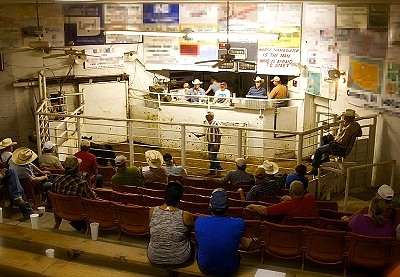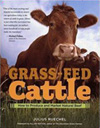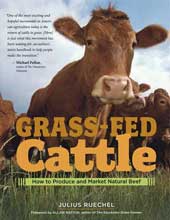Beef Cattle Marketing Options
for Grass Fed Cattle Farmers

Image Credit: Al Jazeera English, Flickr, CC BY-SA 2.0
Although the production side of pasture-raised beef and grass finishing may appeal to you, not everyone wants to get involved with direct-marketing their beef cattle.
Raising pasture-based or grass-fed cattle does not mean that you need to turn your back on the traditional commodity cattle market system. With the right strategies, the commodity beef marketing system can actually be the perfect beef cattle marketing solution for your pasture-raised cattle!
Selling grass fed cattle through the traditional commodity beef marketing channels
The commodity cattle markets provide a huge ready-made large-volume marketing pipeline that will absorb all the beef you can ever hope to produce, and more, without ever having to expend huge amounts of effort to develop your own marketing pipeline. That's time and money saved which can be put towards expanding your cattle farm and fine tuning your production strategies. Furthermore, sticking to the commodity cattle markets means that you don't have to mold your farm's production strategies to fit someone else's market needs - it's such a huge market that whatever you do, and whatever time of year you have cattle available for sale, there's bound to be a buyer waiting to absorb all your product and more.
The clear disadvantage to sticking with the commodity markets is that you get no premium when you sell your grass fed beef. It will be indistinguishable from all other beef when it reaches grocery shelves. No niche-market pricing power.
Which means that the only way to leverage a financial advantage out of your grass fed beef production is to strictly use grass fed production strategies to lower your expenses, not to create a unique product.
But if you're worried your going to miss out on a financial advantage by giving up on the direct-marketing price premium, think again. The cost savings from learning grass fed production strategies can be huge while direct-marketing comes with a considerable price tag. And it's not just the direct costs of running a direct-marketing program. Direct marketing also takes a huge indirect toll on your production strategy because the production side of the business can no longer command 100% of your time, mental energy, and capital resources to keep it improving and running in top form.
Controlling production costs through low-cost pasture-based production strategies
Low-cost pasture-based cattle farming strategies combined with robust cash-flow management strategies, like "sell-buy accounting" discussed in my book, are so powerful that they don't need a marketing premium to be viable!
Want to learn more about 'SELL-BUY' cashflow management and low-cost pasture-based cattle farming strategies?
Then check out my book: Grass Fed Cattle: How to produce and market natural beef.
While that market premium may be hard to give up when choosing to continue to market through the conventional commodity cattle market system, there are massive advantages that come from simply implementing a well-tuned grass-fed production strategy without adopting a completely different marketing program.
Strategies like developing a well-tuned daily pasture rotation, calving on pasture during the summer, learning how to create high-quality winter pastures to extend the grazing season and minimize feed costs, and learning how to select (and cull) replacement genetics for your herd based on strict performance guidelines - just to name a few strategies - add up to a massive reduction in expenses and free up vast swathes of time and money, which can then be poured back into the business to expand your cattle herd and land base.
But sadly many grass-fed farmers find their costs go up instead of down when they switch to grass fed beef production because the bulk of their time and energy (and capital) are being diverted to navigating the unfamiliar territory of developing a brand new marketing strategy and learning a whole new and unfamiliar marketing.
Learning low-cost pasture-based cattle farming strategies is a lot of work. There is a lot to learn, even for cattle producers with a lifetime of experience producing cattle using conventional production strategies. It is unrealistic to expect the pasture-based grass-fed production system to run smoothly as a cohesive, simple, low-cost production strategy if your time and energy are preoccupied with direct-marketing at the same time as the production system is going through a massive transition to pasture-based grass fed production.
Great things happen when we specialize
Great things happen when we specialize, when we focus, when we have the discipline to zero in on only one thing until we trim and tune and mold it to perfection. Great things do not happen when we spread ourselves thinly across many different things at once.
Direct marketing works best as an optional add-on to your farming operation only AFTER you've truly mastered the art of grass fed cattle production. First perfect your production strategy. First become profitable using grass fed production while marketing through the commodity cattle markets.
Only once your production system is a well-oiled machine, when you've got nothing left to improve on the production side of the business, only then are you truly ready to add direct-marketing to your farm. You do your grass fed production strategy a great disservice if you chase after the direct-marketing premium before you have everything else in order! And once you've got your grass fed production strategy truly working like clockwork, you may find that navigating the uncharted waters of developing a direct-marketing program doesn't look quite so attractive compared to keeping it simple and staying 100% focused on what you know and love best - raising cattle.
Know your buyers - squeezing a premium out of the cattle auction system and/or meat packing industry
Just because you forego the direct-market premium doesn't mean there isn't a way to squeeze a premium out of the commodity cattle markets. It just takes knowing a little about market cycles in the beef industry and specializing on your particular niche within that vast industry.
Selling unfinished live cattle
Some grass fed producers will strictly focus on cow/calf and/or stocker grazing and leave the final step of finishing to the feedlots. They either buy weanlings or raise calves from birth, which they fatten on pasture until they are ready to be bought by the feedlots, usually via a cattle auction.
For these grass-fed producers, timing is everything. Calving in summer means their calves can be carried through the winter very cheaply because they haven't been weaned yet. Weaning happens just before the start of the next growing season so weight gains happen cheaply on grass. By mid to late summer, these calves are ready for sale at a time when the majority of conventional cattle producers aren't ready to sell yet (they won't sell until late fall), so cattle prices tend to be higher at this time of year than later when the majority of beef producers come to market. Cheap weight gains, cheap winter feed costs, and market timing add up to a considerable premium. These producers squeeze a premium out of the conventional commodity markets simply by learning the intricacies of price cycles in their particular region combined with optimizing their production system to take advantage of all the natural built-in advantages of cattle and grass. And they reap an advantage by selling out of sync with when the majority of cattle producers buy and sell.
Selling grass-finished cattle
Other grass fed beef operations do take the final step of grass finishing their calves (or by buying calves to finish). However, instead of selling their grass-finished animals to feedlot operators via the cattle auction system, they sell directly to the meat packing companies - the same meat packers that buy cattle from the feedlots. These grass fed cattle operations specialize in finishing cattle cheaply on pasture using low-cost pasture-based grazing strategies. Their price advantage comes strictly from being pasture-based so they can reduce their cost to produce beef. Their entire production system is set up to minimize tractors, harvesters, and labor by designing their grazing program so cattle do all the harvesting. They control the timing of their buying and selling to minimize winter feed costs (i.e. buy smaller calves in the fall when prices are cheaper and then winter then cheaply by grazing as long as possible on carefully-prepared winter pastures). They use "sell-buy" accounting to manage their cashflow. And they slaughter the majority of their animals in summer at a time when meat packers are short on supply because the feedlots tend to be emptier at this time of year.
Selling finished vs unfinished cattle
The live cattle auction system is not ideal for selling finished beef cattle (whether they are finished on grain or grass), because the majority of the buyers at these cattle auctions are feedlot operators, not slaughterhouses. These feedlot operators are not interested in buying finished beef cattle since they only make money when they fatten cattle. So if they do buy your grass finished cattle at auction, they have to discount them to warrant the effort of buying and transporting them only to resell them right away to the meat packers. Thus, selling cattle through the live cattle auction system only is realistic if you sell cattle that are not completely finished so they remain attractive to feedlot buyers.
Consequently, if you want to sell grass-finished cattle (instead of focusing on producing unfinished cattle age groups that feedlot buyers are interested in), you need to make the extra effort of developing a marketing relationship directly with a meat packing business - the same businesses that feedlot operators sell to. This can and is being done by some grass finishing operations. It takes a little more effort than simply selling cattle at auction. But it takes much less effort than developing a direct-marketing program for a niche product. And pricing is relatively transparent thanks to the cattle futures market. Many even lock in favorable prices using future's contracts long before their cattle are ready for slaughter!
Some former feedlot operators use this strategy. They simply convert their forage-growing land base to grass-finishing pastures (such as pure alfalfa pastures combined with a bloat inhibitor in the water) and then simply continue to sell to the meat packers with whom they have dealt in the past.
...
With all of these strategies, once this beef hits grocery store shelves, it will be indistinguishable from feedlot-sourced beef. Profitability comes from controlling costs by developing an extremely efficient and cohesive grass fed production strategy and then squeezing a premium out of the commodity cattle markets through market timing and by taking advantage of the cattle future's markets to lock in favorable prices even before the cattle are ready for slaughter.
Choosing your preferred marketing strategy
Deciding on which route to take to market your grass fed beef is not a simple choice. There are a lot of considerations. Do you want to direct-market a specialty product? Are you willing to develop your own marketing pipeline? Or do you prefer to tap into someone else's marketing pipeline so you can focus on your cattle and your pastures?
If direct-marketing interests you, you should be open to combining your marketing efforts with other grass fed farmers either by selling through a grass fed beef marketing co-op (which you may need to establish yourself!), by selling through another farmer's established grass fed beef marketing pipeline, or by recruiting other grass fed farmers to sell through your marketing pipeline.
If direct-marketing in not your cup of tea, then the pasture-based grass finishing strategies discussed throughout this website still allow you to reduce your production costs while taking advantage of the ready-made marketing pipeline of the commodity beef cattle marketing system - cattle auctions and the meat packers themselves.
Whichever route you choose, your goal should be to harness a beef cattle marketing strategy that can cater to needs and shopping habits of the 21st-century, urban, health-conscious beef consumer.
...
Related Articles:
- Low-Cost Pasture-Based Grazing Strategies
- The example farm plan - a complete grass fed cattle farming strategy, from calving through grass finishing.
(Disclosure: I get commissions for purchases made using Amazon links in my post.)
And when you're ready to start planning your cattle farm, check out my book: Grass-Fed Cattle: How to Produce and Market Natural Beef. Use the links below to explore my book and read reviews on Amazon:

- Amazon.com#CommissionsEarned
- Amazon.ca#CommissionsEarned
- Amazon.co.uk#CommissionsEarned
What's your beef cattle marketing strategy? What challenges do you face in your cattle-marketing program? Do you have any questions about how to market your grass fed cattle? Use the Comments section below to share your thoughts!
|
Page 3 / 3 |
Thumbnail Image Credit: Al Jazeera English, Flickr, CC BY-SA 2.0



